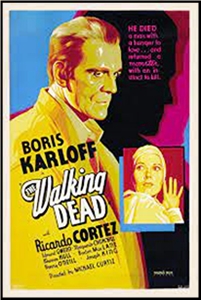December 2022
Monthly Archive
Wed 21 Dec 2022
Posted by Steve under
Reviews[10] Comments
DONALD HAMILTON – The Retaliators. Matt Helm #17. Fawcett Gold Medal, paperback original, 1976.
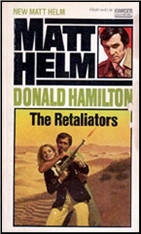
I suppose I could blame it on the movies. This is the latest Matt Helm adventure and the first I’ve ever read. The first impression is favorable, and I really did know Dean Martin wasn’t really right for the part. Helm is a tough government operative, with a philosophy of life nearly as well defined as Travis McGee’s, They do have different bosses, different loyalties, but they share a common disdain for plastic America.
This mission begins as Helm finds an extra $20,000 in his bank account, a worn-out idea that still brings the Bureau of Internal Security down on his neck. And the BIS boys continue to hang around his neck as he heads for Mexico to stop a hit-man named Ernemann from his appointed rounds.
I have the feeling that if Helm had asked himself or some other right person the right question at the right time, the detailed plot would have collapsed long before the final chapter, but then again his loyalties do not always involve asking questions. Smooth writing with a bit of action never more than a couple of pages away, more than enough keep the eyeballs tracking.
Rating: B minus.
– Very slightly revised from The MYSTERY FANcier, January 1977 (Vol. 1, No. 1)
Tue 20 Dec 2022
Posted by Steve under
Reviews[3] Comments
IT IS PURELY MY OPINION
Reviews by L. J. Roberts
DAVID HOUSEWRIGHT – Something Wicked. PI Rush McKenzie #19. Minotaur Books, hardcover, May 2022. Setting: Minnesota.

First Sentence: “Jenness Crawford’s voice trembled with rage.”
Rushmore McKenzie may have retired from the police force, but when a friend of his wife, Nina, asks for help, McKenzie can’t refuse. Jenness believes someone murdered her grandmother despite a lack of evidence. However, her biggest concern is that her siblings want to sell their 1883 home, hotel and restaurant, struggling since the pandemic, to developers. The Sons of Europa, a group calling for the preservation of white families, wants her to sell so zoning laws might be changed, and no one wants that.
Housewright can be relied upon for an excellent sense of time and place, and wonderful dialogue. His realistic inclusion of live in the time of COVID is very well done. He deals with the issues of white supremacy, racism, greed, deceptiveness, infidelity, and more while being objective and non-preachy.
McKenzie, Nina, and the town’s sheriff Deb are the ones who hold the story together and maintain our interest. There is a danger inherent with a plot which centers on a family rivalry; the characters tend to be unpleasant. That was certainly the case here. While Jenness avoided that curse, she was overshadowed by the other characters.
There were significant weaknesses to the book. Exposition can be interesting but unless it moves the plot forward, it’s filler. Predictability is boring. Highly dramatic points at 50 percent and 75 percent makes one think of Midsomer Murders. An ending that tells, rather than shows, seems lazy. Classifying this story as a “locked-room mystery” is deceptive, and a major loose thread, even when acknowledged in the epilogue, wonders why it was there in the first place. Housewright is usually better than this. It seemed as though his heart just wasn’t into this book.
Something Wicked relies on the strength of its principal characters and they don’t disappoint. A protagonist with a strong, committed, supportive relationship is such a pleasure. It may not overcome everything but serves as the core for a decent way to spend a day.
Rating: Okay.
Mon 19 Dec 2022
A 1001 MIDNIGHTS Review
by Bill Pronzini
MIRIAM ALLEN deFORD – The Theme Is Murder. Abelard Shuman, hardcover, 1967.
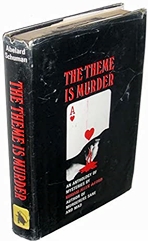
Miriam Allen deFord is best known for her scholarly works on a variety of historical subjects, and for her true-crime studies — the full-length books, The Overbury Affair (for which she was awarded an MWA Edgar in 1961) and Ma Barker (1970), and the collection of short pieces, Murderers Sane and Mad (1965).
But she was also an accomplished writer of short stories, both mysteries and science fiction (and in some cases a combination of the two); beginning in 1944, she published an aggregate of more than 1O0 until her death in 1975 at the age of eighty-seven.
The Theme ls Murder is her only criminous collection, and a first-rate gathering it is. There are seventeen stories here, most of which first appeared in Ellery Queen’s Mystery Magazine; others were originally published in such diverse publications as Shadow Mystery Magazine, the Sixties men’s periodical Dude, and Windsor Quarterly. Most are of the quiet variety, with emphasis on character and unusual backgrounds (an actual homicide case preserved on a cuneiform tablet from 1850 B.C., for instance, in “The Judgment of En-Lil”; or Ancient Rome in “De Crimine”).
One of her favorite themes is familial strife that builds into violence, as in such stories as ”Beyond the Sea of Death,” “The Oleander’ and “A Death in the Family.”
Each of these seventeen tales is finely crafted and thought-provoking — a single-volume legacy from a gifted spinner of mysterious webs. Recommended.
———
Reprinted with permission from 1001 Midnights, edited by Bill Pronzini & Marcia Muller and published by The Battered Silicon Dispatch Box, 2007. Copyright © 1986, 2007 by the Pronzini-Muller Family Trust.
Sun 18 Dec 2022
REVIEWED BY BARRY GARDNER:
NANCY BELL – Biggie and the Poisoned Politician. Biggie Weatherford #1, hardcover, St. Martin’s, 1996; paperback, 1997.

And here we have a first novel by an Austin, Texas lady who is a sorority house-mother at the University of Texas, and who is at work on the next Biggie Weatherford novel.
Biggie Weatherford is the wealthiest woman in the small East Texas town of Job’s Crossing, and somewhat more than semi-eccentric. When the city fathers decide to put a landfill next to her farm and ancestral graveyard she rises up in righteous wrath, which is further fueled by a strip-mining operation sniffing around the area. But before she can accomplish anything a boarder has his car blown up, a city official is killed, and a mysterious stranger shows up in town.
Well, they don’t come any cozier than this-pure fluff and a yard wide, but fortunately not very long (200 pages). It’s even got a recipe at the end, for God’s sake. And I actually sort of (*blush*) enjoyed it. It’s narrated by the lead’s 12 year old grandson in a fairly authentic rural Texas voice, which along with the characters was most of its appeal for me. They were painted with a very broad brush, but anyone who’s lived in a small town won’t have trouble recognizing a few of them.
Bell stumbles once or twice with the voice (a regional first person voice is hard to write for 200 pages, even if you’re raised to speak it) and has a cat doing something a cat wouldn’t do, and the plot is the usual cozy silliness, but if you’re not expecting too much going in, you might be pleasantly surprised.
An aside — I’ll be interested to see if she catches any heat from the P.C. crowd for not only portraying a black woman as a maid, but having her have a shiftless husband and be a voodoo woman as well.
— Reprinted from Ah Sweet Mysteries #25, May 1996.
The Biggie Weatherford series —
1. Biggie and the Poisoned Politician (1996)
2. Biggie and the Mangled Mortician (1997)
3. Biggie and the Fricasseed Fat Man (1998)
4. Biggie and the Meddlesome Mailman (1999)
5. Biggie and the Quincy Ghost (2001)
6. Biggie and the Devil Diet (2002)
Sat 17 Dec 2022
Posted by Steve under
Reviews[2] Comments
ERLE STANLEY GARDNER writing as A. A. FAIR – All Grass Isn’t Green. Bertha Cool & Donald Lam #29. William Morrow, hardcover, 1970. Pocket, paperback, April 1971. Reprinted several times.
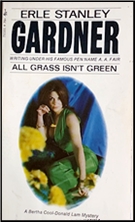
There is a small disagreement in the mystery world about the numbering of this book in the series. The one that was theoretically intended to be number two, The Knife Slipped, was rejected by William Morrow, Gardner’s hardcover publisher – on grounds of being too racy – and did not see the light of day until 2016. (Goodreads calls it book #1.5, and I think they have the right of it.)
What is true is that All Grass Isn’t Green is the final book in the series, and since Gardner is said to have been ill at the time, many reviewers have called it out as being one the weakest. More on that later.
Lam, as the active member of the two-person detective agency (plus a small staff or perhaps only two), is hired by a fairly reticent client to find a man for him. Why, he won’t say. Lam agrees, but with reservations. He quickly learns that the missing man is a freelance writer, that his girl friend has also moved out very suddenly, and that the trail for both leads to Mexico.

That makes up the first third of the book, and Lam’s investigation, as he tells it, is both fun and very much worth following. The middle third is another story altogether. Once in Mexico, Lam discovers that the missing man was very foolishly putting together a story about the marijuana trade. (Hence the title.) Smuggling, that is, and when one of the gang turns up dead, it is somehow Lam’s client who is arrested for the murder.
The story meanders around considerably in this section, with lots of uninteresting routine and repeated trips on Lam’s part back and forth across the border. It’s not until the preliminary hearing that the story picks up again, and with a vengeance. Lam cannot act as a lawyer, so he has to hire one for his client, but in the middle of the proceedings, convinces his client to fire the fellow and to act as his own attorney, with Lam whispering to him what questions to ask.
So the book ends in fine fashion, albeit without the twist in the tale you might expect. The verdict on the book itself is therefore definitely mixed, but I’m glad I finally managed to catch up with this one. As for Bertha Cook, she fries a lot of oysters, but her role is otherwise inconsequentially small. (She never had a large one, or did she?)
Sat 17 Dec 2022

CAROLYN WESTON – Rouse the Demon. Casey Kellog & Al Krug #3. Random House, hardcover, 1976. Brash Books, softcover, 2015.
A psychologist trying hypnotism as therapy for juvenile drug addicts is murdered. Cops Casey Kellog and Al Krug investigate and find Dr. Myrick more apprentice than sorcerer. No miracle cures for this encounter group.
This is the third of the series of novels that inspired the TV show The Streets of San Francisco. It’s plagued by both spotty and shoddy police work, as far as I’m concerned, detracting greatly from a decent plot conception. It’s also very tempting to add that the television actors bring a great deal to their roles, and I would, if I watched it more than once a year.
Rating: C.
– Very slightly revised from The MYSTERY FANcier, January 1977 (Vol. 1, No. 1)
The Casey Kellog & Al Krug series —
Poor, Poor Ophelia. Random House, 1972.
Susannah Screaming. Random House, 1975.
Rouse the Demon. Random House, 1976.
Fri 16 Dec 2022
REVIEWED BY DAN STUMPF:

THE WALKING DEAD. Warner Brothers, 1936. Boris Karloff, Ricardo Cortez, Edmund Gwenn, Marguerite Churchill, Warren Hull, Barton MacLane, and Joe Sawyer. Written by Ewart Adamson, Peter Milne, Robert Hardy Andrews, Lillie Hayward, and Joseph Fields. Directed by Michael Curtiz.
Formulaic but fun.
Warners made a few Horror movies in the 1930s and 40s, some of them quite good, but even at their ghouliest, they never abandoned the tough-guy outlook that was the studio’s stock in trade. Mystery of the Wax Museum, Return of Dr X, The Smiling Ghost and even Beast with Five Fingers to some extent feature dense cops, detectives of varying competence, smart-ass reporters, hardened criminals, and underworld hangers-on. The Walking Dead is distinct from these only in that it features somewhat more organized crime, nicely reinforced by the stylish direction of Michael Curtiz.
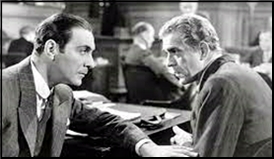
Karloff stars as John Elman, an ex-con who falls into the gears of mob-lawyer Ricardo Cortez’s scheme to rub out an uncooperative Judge, and ends up as the fall guy, fretting on Death Row while a young couple who witnessed the actual killing agonize over whether to come forward to clear him and risk the wrath of heavies like Barton MacLane and Joe Sawyer. There’s a beautifully-done and melancholy “last mile†walk to the hot seat – precursor to the similar trek in Angels with Dirty Faces — word from the Governor comes just as the lights go dim, and then….
Well, it happens that the young couple who came too late to Elman’s rescue are in the employ of eccentric medico Edmond Gwenn, who has just kept a human heart beating outside the body for two weeks and is eager to try a Revival Meeting with Elman’s corpse.
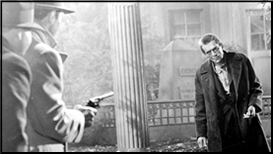
I use the term “Revival Meeting†because there is a strong spiritual component to the last half of this film. The revived man now knows who framed him, and exerts a frightening influence over the nasties that lead to some not-always-convincing fatal accidents. At the same time, Doctor Gwenn is pressuring him for details about things on “the other side†and the source of Elman’s newfound powers.
Karloff sports a frizzy hairdo with a shocking white streak for this part, and walks with the eerie, half-paralyzed shuffle later adopted by Kharis. How much of this is due to his acting or to Curtiz’ direction may be debatable, but the result is quite effective, and the film itself moves along so fast there’s no time to get used to it. It’s a case of actor, director and studio at the top of their form, and a film not to be missed.
Wed 14 Dec 2022

BILL PRONZINI “Gunpowder Alley.†John Quincannon & Sabina Carpenter, 1890s San Francisco. First published in Ellery Queen’s Mystery Magazine, August 2012. Reprinted in The Best American Mystery Stories, edited by Otto Penzler & Lisa Scottoline (Houghton Mifflin, softcover, 2013). Combined with one or two other stories to form The Dangerous Ladies Affair, by Marica Muller and Bill Pronzini (Tor, hardcover, 2017).
One time Secret Service Agent John Quincannon and his partner, a former Pinkerton detective named Sabina Carpenter, have joined forces to establish their own agency, Carpenter & Quincannon: Professional Detective Services, and have had many cases together, mostly individually but on occasion working together. This is a purely professional, as much as Quincannon would wish otherwise. I have not read many of the stories that come after this one, so I do not know whether they ever do get together romantically. Will he? Will she? I cannot tell you.
Quincannon works on this case pretty much solo, but when he finds himself stumped, he always has Sabina to tell his woes to, and not too incidentally, obtain useful advice.
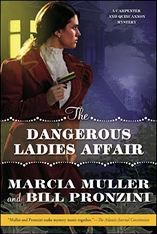
Dead by a fatal gunshot wound is a blackmailer Quincannon had been hired to follow. He is found in the back room and living quarters of the his tobacco shop on a dingy street called Gunpowder Alley. What stumps Quincannon is that the dead man, along with the gun that did the deed, is in a room that can be entered only through two locked doors, with no access through the barred windows.
It is quite a puzzle, and it is no wonder that Quincannon is totally stumped, but after a little of Sabina’s support, he at length figures out how the killing was done. The solution is very meticulously worked up – this is one of those mysteries that once the explanation is given, you the reader (unless you are more clever than I) knocks him or herself on the side of the head and says “Duh.â€
Adding to the pleasure of reading this story is the equally meticulously described setting: 1890s San Francisco, where glitter and dark dismal streets and alleys exist almost side by side.
Tue 13 Dec 2022
GALAXY SF, April 1967. Editor: Frederik Pohl. Cover artist: [Douglas] Chaffee. Overall rating: ***½.

KEITH LAUMER “Thunderhead.†Novelette. A lieutenant of the Fleet Navy, who has manned his planetary post for twenty years, though it is clear that he has been forgotten, receives a message at last. In response, he climbs to the mountaintop beacon and sets a diversion for a fleeing enemy. Deliberately sentimental, the story is obvious from the beginning, but still succeeds. (4)
ROBIN SCOTT “Fair Test.†Aliens consider a segregated Earth. (2)
CHRISTOPHER ANVIL “The New Member.†Bangolia joins the UN and immediately becomes a pest to everyone. Humorous. (2)
JAMES McKIMMEY “The Young Priests of Adytum 199.†The childish survivors of the war do not tolerate deviation from their norm. (5)
HOWARD HAYDEN “The Purpose of Life.†Novella. Dr. West, in telepathic control of Mao III, precipitates a crisis that buries hem and fifty Esks 4000 feet below Peking. The Esks multiply furiously, threatening the food supply, and a tunnel to the surface must be dug. The discovery and fulfillment of the purpose of the Esks on Earth is rather anticlimactic. Immortal life after death requires the death of billions. Dr. West dies too. ***½
[Note: This was number seven of eight stories Hayden wrote about the Esks. These were indigenous Canadian Inuits transformed by an Alien presence into an apparently benign, fast-breeding new species called Esks. (From the online SF Encyclopedia.)]
PIERS ANTHONY “Within the Cloud.†Clouds have a sense of humor also. (3)
KRIS NEVILLE “Ballenger’s People.†Burt Ballenger operates as a nation, as a democracy. (3)
HARRY HARRISON “You Men of Violence.†A mutation of homo spaiens develops, one unable to kill. At least, actively. (3)
–February 1968
Mon 12 Dec 2022
Posted by Steve under
Reviews[2] Comments
REVIEWED BY TONY BAER:
TUCKER COE – Murder Among Children. Mitch Tobin #2. Random House, hardcover, 1968. Signet P4030, paperback, 1969.
Mitch Tobin was kicked off the force. By rule, 2 cops on every call. He and his partner got a routine call, but Mitch had his partner go it alone, as Mitch and his ‘lady friend’ had a ‘date’. The ‘routine’ call turned out anything but, and Mitch’s partner was shot dead.

The force was everything to Mitch. And he lost it. Now he’s got nothing. Nothing but his wife, who for some reason forgives him and still cares for him. A fact equal parts comfort and shame.
All Mitch wants now is to disappear. He is barely of this world anymore. He just wants to read Twain’s Life on the Mississippi and build a brick wall around his back yard. He doesn’t care how long it takes. The longer the better. It’s just the process. Build the wall, read the book. Stay out of this century, stay out of this world. Disengage.
But the world keeps trying to pull him back in.
This time, it’s a cousin, a young pretty hippy-chick. She started a coffee shop in the East Village, but a cop keeps hounding them. She doesn’t know what he wants. Could Mitch please talk to him and ask him to leave them alone?
Mitch isn’t too thrilled by the prospect, but reluctantly agrees. He’s always hated cops on the take — and he figures that’s what this is. He makes a date to go to the coffee shop tomorrow afternoon to talk to the cop.
But when Mitch shows up, his cousin is covered in blood, holding a bloody butcher knife, with two bodies laying abreast of her frozen figure. Still life with knife.
She’s in shock and can’t remember a thing. But Mitch becomes convinced she’s not guilty when the killer comes after him next.
It’s a very short (140 page paperback) detective novel. Most interesting for the fact that Tobin hates himself for his betrayal of his wife and partner. And he feels there’s nothing left for him to do but hide, work on his wall, and read his Twain. The only peace he gets is when he’s put in jail as a suspect. He’s finally released, but would rather not go, if it’s all the same to you. He was kind of enjoying it there.
It’s worth reading for the Tobin character. He’s got to be the most depressed, self-loathing detective I know.
The Mitch Tobin series —
Kinds of Love, Kinds of Death. Random 1966
Murder Among Children. Random 1968
A Jade in Aries. Random 1970
Wax Apple. Random 1970
Don’t Lie to Me. Random 1972
« Previous Page — Next Page »










